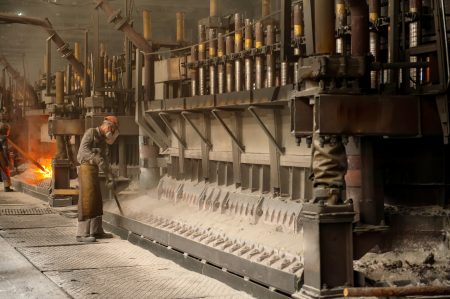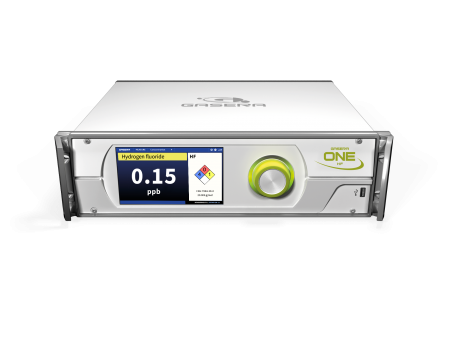HYDROGEN FLUORIDE (HF)
HF is a common raw material for a great variety of industrial products. The global production capacity is over three million metric tonnes. Hydrogen fluoride is used to make refrigerants, herbicides, pharmaceuticals, high-octane gasoline, aluminium (in smelters and refineries), plastics, electrical components (in clean rooms), and fluorescent light bulbs. Sixty percent of the hydrogen fluoride used in manufacturing is for processes to make refrigerants. HF is also used for etching glass and metal.

Hydrogen fluoride (HF) is produced by reacting mineral fluorspar, also known as fluorite, with sulphuric acid and is further used as a reactant for preparing fluorocarbons. It is a chemical compound containing fluorine.
It can exist as a colorless gas or as a fuming liquid, or it can be dissolved in water. When dissolved in water, it forms hydrofluoric acid which is highly corrosive and capable of corroding glass, leather and several metals. HF reacts with water and releases toxic and corrosive vapours.
Hydrogen fluoride (HF) is a significant health risk even in small concentrations. The HF Acute Exposure Guidelines Level 1 value recommended by the United States Environmental Protection Agency (EPA) is 0.8 mg/m3 for 10 min of exposure. Occupational exposure limits in EU are 1.8 ppm/8 h exposure and 3 ppm/15 min exposure. In US, the limits are 3 ppm/8 h exposure and 6 ppm/15 min exposure.
Concentrations exceeding 2 ppm of HF in air cause irritation in eyes and in respiratory tract. HF penetrates through the skin and into the tissues in the body damaging the cells and causes them to not work properly. Breathing HF can damage lung tissue and cause swelling and fluid accumulation in the lungs (pulmonary edema). Skin contact with HF may cause severe burns that develop after several hours and form skin ulcers. Therefore, accurate hydrogen fluoride (HF) monitoring in ambient air is required.
HYDROGEN FLUORIDE (HF) MONITORING AND DETECTION
Particulate fluoride and gaseous HF detection methods are based on active sampling by using 25 or 37 mm cassettes containing a mixed-cellulose ester (MCE) filter uncoated and impregnated with sodium carbonate or sodium formate and analysing it through ion chromatography (IC) or ion-specific electrode (ISE), among others. According to the research these methods are not sensitive enough and involve complex measurement procedures.
Since the HF is highly dangerous gas forming corrosive and toxic hydrofluoric acid upon contact and is capable of causing severe reactions at very low 2-3 ppm-level concentrations, the monitoring device needs to be sensitive to detect HF in very low concentrations (trace level). In order to monitor changes in the background level substantially lower detection limit than the background level is required, i.e. preferably in the sub-ppb level.
HF gas monitor must be very selective in order to distinguish HF from other chemicals present in a multi-component gas mixture, such as the ambient air. HF is also known as a very reactive chemical, which can cause severe system level problems if suitable materials for sample wetted parts are not chosen.
In addition, a fast response time ensures the possibility of real-time monitoring to avoid costly and possibly life threatening spills. Hydrogen fluoride is infrared active gas molecule and thus infrared spectroscopy provides a good basis for detection. Fortunately HF has both strong and isolated molecular transitions (“peaks”) enabling sub-ppb measurement.
BENEFITS OF GASERA’S CANTILEVER-ENHANCED PHOTOACOUSTIC SPECTROSCOPY IN HYDROGEN FLUORIDE (HF) MONITORING
In molecular trace gas analysis, researchers are constantly pushing towards more sensitive, affordable and robust instruments as required by the industry and the scientific community. Modern photoacoustic spectroscopic (PAS) techniques, such as cantilever-enhanced photoacoustic spectroscopy is in the leading edge of this progress as they meet the criteria.
The benefits of this technology are:
-
- Photoacoustic (PA) detector combines the gas cell and the detector in same functional package.
- Sensitivity is not dependent on the absorption path length which enables wide linear dynamic range and compact footprint.
- Modern IR lasers provide high output power.
- Wavelength tuning allows scanning over spectral peaks and the use of chemometric analysis tools.
- High sensitivity is possible with ultra-sensitive pressure detecting technology.
- Absorption is measured directly in PAS, which makes the measurement very accurate and free of drift offering stability and reliability, easy to use
- Cantilever sensor provides high sensitivity with below ppb detection limits
- Sensitivity is not dependent on the optical path length offering a wide linear dynamic range and low sample volume.
The following examples of HF measurements in both laboratory and cleanroom conditions illustrate the usability of the Gasera’s photoacoustic technology in HF monitoring.



Read more about Gasera’s cantilever-enhanced photoacoustic technology at https://gasera.fi/technology/
GASERA ONE HF – HYDROGEN FLUORIDE GAS MONITOR

GASERA ONE HF combines the cantilever enhanced photoacoustic sensor with a tunable diode laser source operating at a NIR fundamental spectral absorption line of hydrogen fluoride. This combination provides sensitivity and selectivity to reliably measure ambient background levels of hydrogen fluoride below 0.5 ppb detection limit. Additionally, GASERA ONE HF offers HF measurements without consumables or wet chemistry making it an excellent monitoring tool of the HF.
SUMMARY
- Hydrogen fluoride (HF) is a key compound in many industrial processes.
- HF is a significant health risk at workplaces where it is used and may also cause environmental pollution.
- Using photoacoustic spectroscopy principles and technology combined with tunable diode laser source provides an attractive platform for sensitive and selective HF monitoring.
- Very low volume measurement cell enable practically realtime detection of a very reactive and difficult analyte.
- GASERA ONE HF offers excellent sensitivity and selectivity to measure extremely low levels of HF in ambient air.
REFERENCES
Cho SY, Woo KH, Kim JS, et al. Acute Symptoms in Firefighters who Participated in Collection Work after the Community Hydrogen Fluoride Spill Accident. Ann Occup Environ Med. 2013;25(1):36. Published 2013 Nov 28. doi:10.1186/2052-4374-25-36. Available online
Dugheri, S., Bonari, A., Pompilio, I., Monti, A., Mucci, N. & Giulio Arcangeli, “Innovative Monitoring of Atmospheric Gaseous Hydrogen Fluoride”, International Journal of Analytical Chemistry, vol. 2016, Article ID 2129053, 8 pages, 2016. Available online
EPA (United States Environmental Protection Agency), “Method 14A, determination of total fluoride emissions from selected sources at primary aluminum production facilities,” Code of Federal Regulation, vol. 40, no. 60, pp. 821–830, 1998.
European Chemical Bureau () European Union Risk Assessment Report. Hydrogen fluoride. CAS No.: 7664-39. EINECS No.: 231-634-8. Available online
National Institute for Occupational Safety and Health (NIOSH), “Fluorides aerosol and gas by ISE,” in Manual of Analytical Methods, Method 7902, Issue 2, 4th edition, 1994.
NIOSH (National Institute for Occupational Safety and Health), Particulate Fluorides and Hydrofluoric Acid by Ion Chromatography, Method 7906, Issue 2, Manual of Analytical Methods, 5th edition, 2014.
OSHA (Occupational Safety & Health Administration), Method Number ID-110, Fluoride (F & HF) in Workplace Atmospheres, Sampling and Analytical Methods, 1991. Available online
Tomberg, T., Vainio, M., Hieta, T. et al. Sub-parts-per-trillion level sensitivity in trace gas detection by cantilever-enhanced photo-acoustic spectroscopy. Sci Rep 8, 1848 (2018). Available online
USGS (United States Geological Survey), Fluorspar, statistics and information, July, 2016. Available online
Yang, Y. J. , M. Hyland,Z. W. Wang & C. Seal. Canadian Modelling HF generation in aluminium reduction cell. Metallurgical Quarterly. The Canadian Journal of Metallurgy and Materials Science, Volume 54, 2015 – Issue 2, pp. 149-160. Available online
Read also: Gasera’s peer-reviewed research articles.



